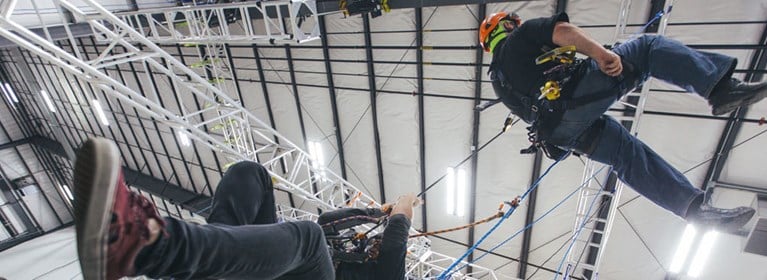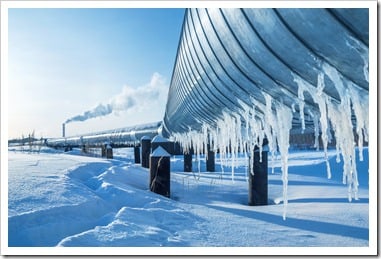
Is Your Material Handling Equipment Tough Enough for Arctic Environments?
Mining, Petroleum and Gas | Hoisting & Lifting | By | Oct 07, 2014


With increasing demand for the exploration and production of natural resources in North Dakota, Alaska and other northern regions in the U.S. and Canada, there is a growing need for cranes and lifting equipment that can withstand exposure to ultra-cold temperatures. When selecting and specifying these products, careful consideration must be given to site conditions that could affect the safety and use of these heavy-duty lifting devices.
Choosing the correct hoists, cranes or rigging products for an application is always critically important due to the inherent risks involved in overhead lifting.
If specified incorrectly, the potential for costly equipment damage, personal injury and lost productivity resulting from failure of overhead lifting equipment can be very significant. While reputable manufacturers of lifting equipment utilize sound engineering, quality materials and have safety factors designed into their equipment, it is important to note that most manufacturers’ standard capacity ratings and duty classes do not take into account the impact that extreme cold temperatures can have on structural steel and other construction materials. This fact is borne out in a variety of industry standards.
Some of these include:
- ASME (The American Society of Mechanical Engineers) ASME HST-2-1999 Performance Standard for Hand Chain Manually Operated Chain Hoists states “The hoists and trolleys covered by this Standard are intended for industrial use in ambient temperatures from 0° F (-18° C) to 130° F (54° C).”
- ASME HST-1-1999 Performance Standard for Electric Chain Hoists and ASME HST-4 Performance Standard for Overhead Electric Wire Rope Hoists both state “hoist equipment is designed to operate in ambient temperatures between 0° F (-18° C) and 104° F (40° C).”
- DNV Standard for Certification No. 2.22 Lifting Appliances, June 2013 states that for shipboard/industrial cranes (including derrick crane, gantry crane, overhead traveling crane, knuckle boom cranes) if not otherwise specified a design temperature of -10° C (14° F) shall be applied. This is a reference temperature to be used as a criterion for the selection of steel grades.
- ASME B30.20 Below the Hook Lifting Devices states that additional considerations need to be taken if the working temperature is outside the range of -4 degrees C to 66 degrees C. It suggests that engineers either de-rate the capacity or use steel that is better suited for low temperature service.
The Impact of Cold on Steel and other Construction Materials
These and other standards reinforce the point that “standard” lifting equipment may not be suitable for use in extreme cold. The temperature limitations set forth in these documents may vary slightly from one standard to another, but they all recognize that temperature can negatively affect the safe working capacity of lifting equipment.
Cold temperatures can adversely affect the tensile toughness of many commonly used materials. Tensile toughness is a measure of a material’s brittleness or ductility. Ductile materials can absorb a significant amount of impact energy before fracturing, resulting in deformations (bending) that can alert the operator to an overload situation before a failure occurs. Brittle materials, on the other hand, can shatter on impact. Many materials experience a shift from ductile to brittle if the temperature drops below a certain point. The temperature at which this shift occurs is commonly known as the “ductile-to-brittle-transition” temperature (DBTT). Any brittle failure will be catastrophic and the failure will not necessarily be predictable. It can occur from a random impact, dynamic loading or can propagate out of a stress riser such as a crack or nick.
The Effect of Cold on Other Components
In addition to the effects of cold on steel and other construction materials, we must also consider the suitability of items such as motors, control components, hydraulic fluids, gear box lubricants and welding in these environments. It is important to consider the minimum ambient temperatures that may be present in the location that the hoist, crane or rigging will be used. Cold can cause some oil to become so thick that it cannot be pumped or be relied on as a “splash lubricant”. Grease can become stiff and solidify, causing grease-lubricated rotating parts to seize up.
Ensure Safety when Selecting Lifting Equipment for Arctic Environments
Reading and understanding applicable safety standards and consulting with experienced and reputable equipment manufacturers are two important steps in ensuring operator and facility safety when selecting hoists, cranes and rigging equipment for cold temperature applications.
- Columbus McKinnon offers cranes, hoists, trolleys and rigging hardware designed and manufactured to order in North America, rather than being mass produced and warehoused. Many of these products lend themselves to modification and substitution of materials, allowing the equipment to be tailored to a specific application. Our Application Engineers are available to work with customers to determine the correct equipment, special componentry and any required design modifications based on a customer’s operating environment, capacity, and service requirements.
- Chester Hoist and Yale Cable King hoists, trolleys and crane components can be offered with special cold temperature steels, heated control enclosures, gear box heaters, artic-duty motors, low-temperature lubricants, special material certification (Charpy’s V- Notch ), material traceability reports, NDT of load bearing welds, and certificate of suitability for arctic duty (includes minimum temperature rating).
- CM DNV Shackles and DNV Master Sub- Assemblies are certified to meet DNV standards for Offshore Container Specifications and comply with DNV Lifting Appliances Requirements. These products also exceed Charpy’s V-notch impact strength of 42 Joules at -20°C (31 ft-lb at -4°F) as per DNV 2.7-1.
Working with Columbus McKinnon Application Engineers to address your low-temperature equipment needs, along with adhering to proper maintenance procedures and operator training, should allow for safe and uninterrupted operation of hoists and cranes even during periods of extreme cold. Be sure to take into consideration the specific stresses that cold-temperatures put on heavy-duty lifting products to keep your workers safe and prevent dangerous accidents on your worksites.



 North America - EN
North America - EN


